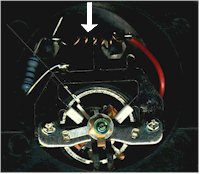Every electronics hobbyist needs a good power supply. Generally to start off,
you'll want a 5 VDC and an adjustable power supply. I used an old 24VAC center tap
'wall wart' transformer, a 7805, 7812 and LM317T for my supply. So I could use my
multimeter for something other than monitoring supply voltage on the variable supply, I
purchased a Radio Shack ammeter.
The chips are each only capable of delivering one amp of power, and the transformer can
deliver 1.6 amps. The Radio Shack ammeter measures up to 500mA. This means
that if I wanted it to go full scale at 25 VDC, it would be using half of my supply
current! Deciding this was unacceptable, I did the only thing an engineer could do -
I took it apart. Here is the inside:
| You should note that the ammeter actually contains
a shunt across the resister and meter movement (see arrow). I don't have a schematic
program yet, but here is an ascii diagram for laughs: |
 |
Input+ ---+-------+
| .-^-.
Shunt-> : |meter|
| '-.-'
Output- ---+-/\/\/-+
Resister--^
|
I clipped one end of the shunt and bent it backwards (in case future modifications
warrented a shunt) And played with it. I found that clipping the shunt made the
meter into a 5mA ammeter, much more acceptable a current loss than .5A. I put the
appropiate resisters in series and added a switch so I could measure 0-25VDC, and 0-5VDC
for low power applications
The end result, after a box from RS, is a power supply with +5, +12, and 1.25-24VDC
outputs. Eventually I may put another switch or two in so I can use the meter to
measure current as well as voltage.
I plan on building a switching power supply into this box as well, since supplying the
5 volt regulator with 24V unregulated creates quite a voltage drop and resulting power
loss.